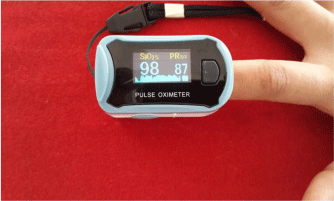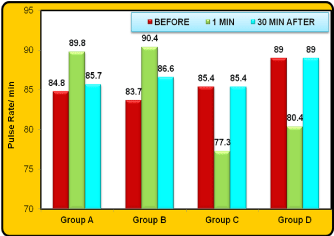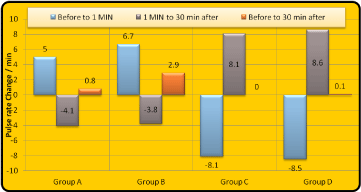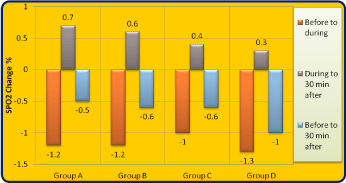
Special Article - Pediatric Dentistry
Austin Pediatr. 2016; 3(2): 1034.
Incident and Extent of Pulse Rate and Oxygen Saturation Alteration during Local Anesthesia in Children
Patil SB*, Bondarde PA, Patil PM and Mujawar SM
Department of Pedodontics and Preventive Dentistry, ACPM Dental College, Dhule, India
*Corresponding author: Sudha B Patil, Associate Professor, Department of Pedodontics and Preventive Dentistry, ACPM Dental College, Dhule, India
Received: July 13, 2016; Accepted: August 02, 2016; Published: July 15, 2016
Abstract
Introduction: Local anesthesia is routinely used for dental procedures in children. Hypoxia is the most important side effect which can be detected early by pulse oximeter during the procedure. The purpose of study is to investigate pulse rate and oxygen saturation alteration in children during LA administration.
Aim: To estimate incident and extent of oxygen saturation and pulse rate alteration during local anesthesia in children.
Objectives: 1) To estimate the variation of pulse rate during LA administration with and without vasoconstrictors. 2) To estimate the variation of oxygen saturation during LA administration with and without vasoconstrictors.
Materials and Methods: 100 children from age group 6-12 yrs of age, who come for routine dental treatment will be selected for study. Pulse rate, oxygen saturation will be calculated before, during and after LA administration.
Result: Significant variation in alteration of pulse rate is seen during LA administration which was not clinically considerable and less variation is seen in blood oxygen saturation levels.
Conclusion: Pulse rate and oxygen saturation vary in anxious patients. Any major fluctuation in these variables which is noted early, may alert us to prevent any medical emergency during routine dental procedures.
Keywords: Hypoxia Pulse rate; Oxygen saturation; Pulse oximeter; Local anesthesia
Introduction
When you prepare for an emergency, the emergency ceases to exist. Emergencies in pediatric dental patients are more or less Respiratory in nature. The customary method of visually observing the patient for signs of depressed respiration for instance cyanosis of the lips, mucosa, and nail beds is insufficient. These signs occur delayed in the chain of events leading to respiratory arrest. Cyanosis is the occurrence of over 5.0g of desaturated hemoglobin per 100ml of blood and not visible in tissue until the 02 saturation reaches a point of at least 75% or lower. Alterations in heart rate, blood pressure, and ECG are delayed signs of hypoxemia. These, in conjunction with cyanosis, are poor indicators of mild to moderate hypoxemia. Because visual observation and vital signs are unpredictable in accurately determining the adequacy of oxygenation, Respiration may become severely compromised and arrest may occur before a problem is detected [1].
“Pulse oximetry is the most major technological advance ever made in monitoring the health and safety of patients during anesthesia, recovery and critical care [2].
It places a pulsating vascular bed between a two-wavelength light source and a detector. By passing the light through the vascular bed it is possible to measure, through light absorption, the variation between “red” oxy hemoglobin and “blue” reduced hemoglobin. The pulse oximeter is generally applied to a finger or toe containing the light source and the detector. A beat-to-beat percent of oxygen saturation and heart rate appears as a digital readout. The instrument is totally noninvasive and an excellent association has been demonstrated between pulse oximetry and arterial blood gas determinations in adults and children [1].
Arterial oxygen saturation is measured as SpO2 in pulse oximeter. Drop in arterial saturation below normal (95-100% in coastal altitude) is indicated by ringing of its alarm. A mild hypoxemic episode can be defined as a SpO2 between 90% and 94%, a moderate hypoxemic episode between 85% and 89% and severe hypoxemia when <85% [3].
Local anaesthesia is routinely used for dental procedures in children. Lidocaine is available in different concentrations of 0.5%, 1%, 2%, 5% and 10%. Technique of anesthesia is either an infiltration or nerve block [4].
Using of local anesthetic agents containing vasopressor agents can lead in hemodynamic changes like increase in blood pressure and pulse rate. Although these changes are without complications in many patients, one has to use them carefully in patients with cardiovascular diseases.
Newspaper articles reveals several incidences where local anesthesia was involved and resulted in death of several children from age group 2 -10 years. The mystery remains unsolved. The dentist is posed with questions such as
- Does local anesthesia cause any major systemic change?
- Does LA administration technique have any significant difference on vital parameters?
- Is local anesthesia safe in children?
- To estimate the variation of pulse rate during LA administration with and without vasoconstrictors in infiltration and block technique.
- To estimate the variation of blood oxygen saturation during LA administration with and without vasoconstrictors in infiltration and block technique.
- 6-12 yrs children undergoing routine extractions & pulp therapy.
- No known medical history of allergy.
- Venham’s anxiety rating scale 0-1.
- No significant difference of Gender and Weight of patients in between the groups
- History of allergy to LA
- Uncooperative children
- Children with systemic diseases
- Caused mean rise in Pulse rate of 5/min and 6.7/min respectively during procedure (p<0.001).
- In both these groups mean pulse rate reduced by 4.1/min and 3.8/min from during LA administration till 30 min after procedure respectively (p<0.01).
- There was statistically no significant (p>0.05) mean difference of pulse from before to 30 min after procedure.
- Does local anesthesia cause any major systemic change?
- Does LA administration technique have any significant difference on vital parameters?
- Is local anesthesia safe in children?
- William A Mueller, John N Drummond, Thomas A Pribisco, and Richard F Kaplan. Pulse Oximetry Monitoring of Sedated Pediatric Dental Patients. Anesth Prog. 1985; 32: 237-240.
- W W Schratz. Pulse oximetry: a review with emphasis on applications in dentistry. Anesth Prog. 1987; 34: 100- 101.
- Shivananda H, Kepu V R, Sharath K Sr, Biju T, et al. Comparative Evaluation Of Oxygen Saturation During Periodontal Surgery With Or Without Oral Conscious Sedation In Anxious Patients. J Indian Soc Periodontol. 2014; 18: 718-722.
- Becker D. Drug Allergies And Implications For Dental Practice. Anesth Prog. 2013; 60: 188-197.
- Bible D, Gagliardi J, Ghorbanpour M, Ghoreshi N, Lau D. A Systematic Review Of Cardiovascular Effects Of Epinephrine On Cardiac Compromised Dental Patients. J Can Dent Assoc. 2008; 15: 123-131.
- Bayat M, Zaeri F, Sadatnia F. Comparison Of O2 Saturation, Heart And Respiratory Rate Following Injection Of Vasoconstrictor Containing Anesthetic (Lidocaine 2%) And Without Vasoconstrictor Anesthetic (Mepivacaine). Jdm. 2005; 18: 45-50.
- Replogle K, Reader A, Nist R, Beck M, Weaver J, Meyers WJ. Cardiovascular Effects Of Intraosseous Injections Of 2 Percent Lidocaine With 1:100,000 Epinephrine And 3 Percent Mepivacaine. J Am Dent Assoc. 2000; 130: 649- 657.
- Ogunlewe MO, James O, Ajuluchukwu JN, Ladeinde AL, Adeyemo WL, Gbotolorun OM. Evaluation Of Haemodynamic Changes In Hypertensive Patients During Tooth Extraction Under Local Anaesthesia. West Indian Med J. 2011; 60: 91-95.
- Mohammad Ali Ghavimi1, Javad Yazdeni, Arezo Ghoraishi Zadeh, And Afshar Abdolkarimi. Comparison of Heart Rate And Blood Pressure Administration Of Anesthesia Agent With And Without. Int J Curr Res Aca Rev. 2014; 2: 153-158.
- J G Meechan, B Cole And R R Welbury. The Influence Of Two Different Dental Local Anaesthetic Solutions On The Haemodynamic Responses Of Children Undergoing Restorative Dentistry: A Randomised Single-Blind, Split-Mouth.Study. Br Dent J. 2001; 190: 502-504.
- Nedal Abu-Mostafa, Fatimah Al-Showaikhat, Fatimah Al-Shubbar, Kawther Al- Zawad, Fatimah Al- Banawi. Hemodynamic Changes Following Injection Of Local Anesthetics With Different Concentrations Of Epinephrine During Simple Tooth Extraction: A Prospective Randomized Clinical Trial. J Clin Exp Dent. 2015; 7: E471-76.
- Carrera’, R Mestre’, L Berini’, C Gay-Escoda’- Bull. Álterations In Monitored Vital Constants Induced By Various Localánesthetics In Combination With Different Vasoconstrictors In The Surgical Removal Of Low~R Third Molars L. Group. Int. Rech.Sci. Stomatol. Odontol. 2000; 42: 1-10.
- Laligan CJ. Oxygen Desaturation After Dental Anaesthesia. Br J Anaesth. 1992; 68: 142-145.
- Malkaa Shkenadzim, Bde Atricpe Greenbedrgm, Hda Ims Arnatd, Severe Hypoxia Following Local Anesthesia In A Sedated Patient. Case Report. Pediatric Dentistry. 1998; 20: 359-360.
The purpose of the present study was to compare the incidence and extent of pulse rate and oxygen saturation alteration in children using local anesthesia with and without adrenaline and in infiltration and block technique in pediatric dental patients.
Methodology
Objectives
Null hypothesis
No variation in Pulse rate & blood Oxygen saturation levels at different intervals and different LA administration technique.
Inclusion criteria
Exclusion criteria
Study was carried in 3 month period from August 2015 to November 2015 in the Department of Pediatric dentistry of ACPM Dental College, Dhule, Maharashtra, India. The study was carried out on 100 children with in age group of 6-12 years age undergoing routine dental procedures
Chi – square test was applied on age groups and there was statistically no significant (p>0.05) difference of gender and weight of patients in between the either of four groups.
Patients behavior was shaped before administrating local anesthesia using tell show do technique (non pharmacological behavior management, Venham’s anxiety grading was done and only those patients, who were co-operative and potentially cooperative (0- 1-2 on venham scale 1977) were selected for study.
100 patients were randomly allocated to 4 groups with 25 in each group.
Group I -Patients received of lignocaine 2% with adrenaline (1:200000), block technique was used.
Group II - Patients received lignocaine 2% with adrenaline (1:200000) infiltration technique was used.
Group III - Patients received lignocaine 2% plain local anesthesia, block technique was used.
Group IV - Patients received lignocaine 2% plain local anesthesia, infiltration technique was used.
Comparisons of VENHAM score before procedure of patients in different groups. There was statistically no significant (p>0.05) difference of distribution of patients according to Venham’s scale before procedure in between the four groups.
Once the behavior was managed, before administrating local anesthesia, patients pulse rate and oxygen saturation reading were taken using GIBSON finger pulse oximeter (Figure 1)-1st reading. So as per the group, patients received LA and during 1 minute of LA administration pulse rate and oxygen saturation readings were taken by passive observer- 2nd reading. Thirty min after LA administration both readings were again taken and all readings were entered in patients chart-3rd reading.

Figure 1: Gibson Finger Pulse Oximeter.
Data was analyzed using ANOVA analysis of variance test, Chi square test and Mann Whitney Test. Each aberrant event which may occur during L A administration such as gag reflex, coughing, or pain related disruptive behavior was documented by another person who was not the operating dentist. In case of positive aspirations the syringe was discarded and new syringe was loaded with LA solution.
Ethical criteria
Before starting the study, steps of research was explained to Parents/guardians orally and in an understandable language and written consent obtained from them.
Result
Pulse rate (mean ± S.D) of patients before, during and after 30 min in four groups (Figure 2). In Group A mean pulse rate of patients before the procedure was 84.8/min which has risen to 89.8/min and reduced after 30 min of procedure to 85.7/min.

Figure 2: Pulse Rate (Mean ± S.D) of Patients Before, During and After 30
Min in Four Groups.
Group B patients had mean pulse rate of 83.7/min before procedure which had risen to 90.4/min during the procedure and had reduced after 30 min to 86.6/min. In Group C mean pulse rate of patients before the procedure was 85.4 /min which has lowered to 77.3/min during procedure and raised after 30 min of procedure to 85.4/min.
Mean Pulse rate in Group D patients was 89/min which reduced to 80.4/min during the procedure and had raised back to mean value of 89/min, 30min after the procedure.
Percentage Oxygen saturation (mean ± S.D) of patients before, during and after 30 min in four group (Figure 3).

Figure 3: Percentage Oxygen Saturation (Mean ± S.D) of Patients Before,
During 1 Min of La Administration and After 30 Min in Four Group.
Mean Percentage Oxygen saturation in Group A patients before procedure was 97.6, which slightly reduced to 96.4 during procedure and raised to 97.1 after 30 minutes of procedure.
In Group B mean Oxygen saturation was 97.9% which reduced to 96.8 during the procedure and raised back to 97.4% after 30 minutes. In Group C mean O2 saturation was 97.9% which reduced to 96.8 and raised to 97.3 after 30 min of procedure. Group D patients had mean Oxygen saturation of 97.9% before procedure which had reduced to 96.6% and had raised to 97% after 30 minutes of procedure.
If we compare pulse rate change at 4 intervals
Pulse rate change (mean ± S.D) of patients at different interval in four groups (Figure 4).

Figure 4: Pulse Rate Change (Mean ± S.D) of Patients at Different Interval
in Four Group.
In Group A and Group B presence of vasoconstrictor with LA in Block and Infiltration techniques
In Group C and Group D, LA in Block and infiltration technique had no vasoconstriction and had caused mean fall of pulse rate by 8.1/ min and 8.5/min during procedure than initial reading. There was rise of mean 8.1 pulse/min and 8.6 pulse/min after 30 min of procedure than that of during procedure in either of the groups. There was no mean difference of pulse in Group C while a mere 0.1 pulse/min in Group D in between the before to 30 min after procedure findings.
Oxygen saturation change (mean ± S.D) of patients at different interval in four groups (Figure 5).

Figure 5: Oxygen Saturation Change (Mean ± S.D) of Patients at Different
Interval in Four Group.
Due to presence of vasoconstrictor in Group A and Group B there was a slight mean fall of 1.2% SPO2 in both groups during the procedure compared to initial findings.
After 30 min of procedure there was mean rise in SPO2 by 0.7% and 0.6% in Group A and B respectively compared to the during procedure readings. There was a very slight mean fall of 0.5% and 0.6% of SPO2 between the before and after 30 min of procedure results in Group A and Group B respectively.
In Group C and Group D there was slight reduction of SPO2 by 1% and 1.3 % respectively during the procedure. Mean SPO2 after 30min of procedure had raised by 0.4% and 0.3% in group C and Group D respectively than during procedure.
There was mean difference of SPO2 to be 0.6% and 1% lower after 30 min procedure than before procedure in Group C and Group D respectively.
Discussion
The finding of this research was slight increase in pulse rate after injection of lidocaine 2% with epinephrine in either infiltration or inferior alveolar nerve block. Though this rise in pulse rate was statistically significant, it was not numerically and clinically considerable. The meta-analysis conducted Bible et al, expressed that lidocaine + epinephrine which induce anesthesia in dental procedures lead to increase the systolic and diastolic blood pressure and also heart rate. These findings are consistent with our results [5]. Dr. Bayat and colleagues investigated the hemodynamic changes following the use of Lidocaine and Mepivacaine + epinephrine in the patients and stated that after injection of Lidocaine + epinephrine, the 12.25 beats were added to the heart rate every per minute and this change is very significant so Lidocaine + epinephrine combination. It should be noticed that the results of our study were the same as Bayat et al’ results [6]. Salonen and colleagues showed that the use of Lidocaine in combination with epinephrine caused a significant increase in heart rate of the patients which are comparable and consistent with our findings [7].
Furthermore the Reploge et al’ findings were consistent with our too. In contrast to our results, Ogunlewe and colleagues didn’t report the significant changes following the use of anesthetic drugs containing epinephrine [8].
In a study conducted by Mohammad Ali Ghavimi et al. In 182 adult patients, the heart rate changes of the patients anesthetized with lidocaine 2% along with epinephrine were significantly more than those who were anesthetized with Mepivacaine 3% (P<0.001). They concluded that changes in heart rate have been in normal range in healthy patients and it would not be problematic, however patients with cardiovascular patients during dental procedures, use of those drugs which have no pressure vessel materials such as Mepivacaine is recommended [9].
Under real conditions of restorative treatment in children the use of an epinephrine containing local anaesthetic solution caused an average increase in pulse rate of just over 5 beats per minute approximately a 6% increase. The significance of this in clinical terms is difficult to assess. Even mild exercise will elevate pulse rates more than was shown here. Data shows that the range of normal responses to the combination of local anaesthesia and dental treatment is within the range of normal haemodynamic responses [10].
The present study showed that injection of lidocaine (1.8 ml) without epinephrine caused reduction of pulse rate in either infiltration or nerve block. This may be attributed to vasodilative effect of Lidocaine. There was no major change in oxygen saturation alteration during LA administration in children in either groups during LA administration. However in groups C and D (without epinephrine) the mean difference in oxygen saturation was slightly more than group A and B.
In a study done by Nedal Abu-Mostafa et al on articaine with different concentration of epinephrine. Group 1: received 2 cartridges of lidociane 2% with epinephrine 1:80,000 (L 80). Group 2: received 2 cartridges of articaine 4% with epinephrine 1:100,000 (A 100). Group 3: receive 2 cartridges of articaine 4% with epinephrine 1:200,000 (A 200). The mean of oxygen saturation decreased 3 minutes after local anesthetic injection (SpO2)2 in all groups but the significance presented only in G2 (p=0.014). After extraction, oxygen saturation further decreased in G2 and G3 (SpO2)3 whereas it increased in G1 to take the same level of (SpO2).
Which is consistent with our results. Pulse rate and oxygen saturation vary in anxious patients. Any major fluctuation in these variables which is noted early, may alert us to prevent any medical emergency during routine dental procedures [11].
In a study conducted by carrera et al The SaOz values remained constant throughout dental surgery, regardless of the anesthetic combination involved and without intergroup variations. Both the mean maximum value at extraction (98.7%) and the mean minimum value at the end of suturing (95.8%) were within the normal range (hypoxemia being defined as SaÜ2 <95%). Which is again similar to the results obtained in our study [12].
Patients undergoing treatment under concious sedation and general anaesthesia have shown significant drop in oxygen saturation whereas the same is not observed in local anaesthesia [13,14].
Conclusion
This study concludes, although there are variations observed after Local Anaesthesia administration the results are not clinically significant. Hence this answers the questions previously raised before the study.
In healthy patients LA administration below the maximum lethal dose and as per the weight of the children does not cause any major systemic changes provided a proper LA procedure is done with no positive aspirations. It causes minor changes in the vital parameters which are not clinically significant. And yes LA administration is safe in healthy children.
References